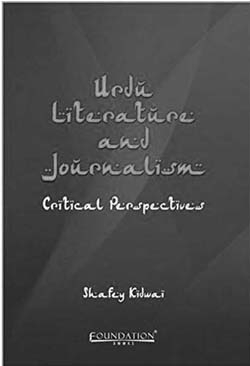Shafey Kidwai’s book is true to its title and it delivers what it promises. The chapters in this book may have been written over a long period of time but probably the book was waiting for a time when the distinction between literature and nonliterature (read journalism) is not so sharp. A different context would make earlier journalistic writings appear as literature. How do we read the essays of Addison, Matthew Arnold or Sir Syed Ahmad Khan today if not as literature? The two components of the book, literature and journalism, are defined by their textuality, a major point of debate in critical theory today. This awareness gives Kidwai’s book a unity of purpose. At times turgid and verbose but at other times lucid and anecdotal, but critically alert all the time, the book has on display different writing styles of the author. If the chapters on Urdu literary criticism have the inevitable dry air, the ones on Urdu journalism are marked by a very racy narrative style.
The first two chapters of the book give a bird’s eye view of the development of the Urdu short story and poetry after Independence. From Premchand and Saadat Hasan Manto to Tariq Chatari and Khalid Javed, Kidwai traverses a long trajectory stopping in between to give glimpses of the art and craft of the canonic and yet to be canonic stories. Though the stilted style and the use of too many unfamiliar words in some passages of the chapter slightly hampers readability, those new to Urdu stories get a fair idea of what to look for. Almost similarly structured is his chapter on Urdu poetry after Partition which he divides into three phases—progressive, modern and postmodern. It can be added that any neat division is problematic as postmodern does not necessarily start where the modern ends and the progressive does not totally disappear from view. A number of poets ranging from Ali Sardar Jafri to Mahtab Haider Naqvi are placed in perspective by Kidwai. Naqvi’s ability to give a new meaning to old and familiar symbols of ghazal, noted by Kidwai, reminds one of poets like D.H. Lawrence in whose hands the familiar figure of snake is liberated from its negative connotations. This chapter is especially remarkable for noting the humanitarianism of the progressives and tracing the cerebral tradition in Urdu poetry which encompasses the work of Iqbal, N.M. Rashid, Akhtarul Iman, Ameeq Hanfi, Shahriyar and Khalil Mamoon. In this long chapter which includes extracts from the poets quite liberally, Kidwai gives his English readers a genuine feel of Urdu poetry. His selection of English translations of the poems, most of which were published in the Sahitya Akademi’s journal Indian Literature and hence can be accessed easily, is flawless. On many occasions Kidwai himself successfully dons the role of the translator. His translation of many prose passages, especially those of Josh Malihabadi, Premchand and Marxist Urdu critic Ehtisham Husain, reveals Kidwai as a very accomplished translator in his own right. Shafey Kidwai demonstrates his ability to grapple with both modern and archaic Urdu texts.

